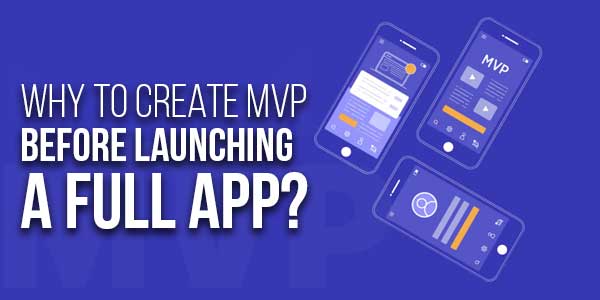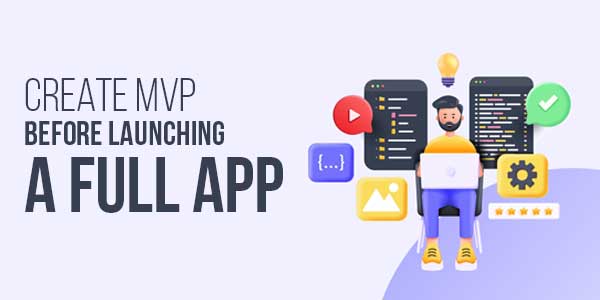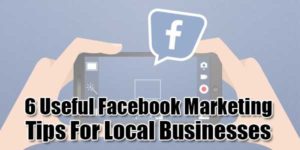
Launching a new app is an exciting venture, but diving straight into full-scale app development can be risky. This is where the concept of a Minimum Viable Product (MVP) comes into play. MVP is a strategy where you create a stripped-down version of your app, featuring only the core functionalities necessary to address the primary problem your app aims to solve.
In this post, we’ll explore why building an MVP before launching a full app is not only a wise approach but also essential for long-term success.
Table of Contents
What Is An MVP?
Definition Of MVP:
An MVP, or Minimum Viable Product, is a development technique in which a new product or app is developed with basic but sufficient features to meet the needs of early users. These features are often the most crucial ones required to solve the main pain points of the target audience. Once the MVP is launched, feedback from the early adopters is gathered to improve and build the full version of the product.
Key Elements Of An MVP:
- Core Features Only: Focus on the essential features that define the core value of your app.
- Early Feedback: It allows you to collect valuable insights from initial users.
- Iterative Development: Improvements are made based on real-world usage and feedback.
Why Should You Create An MVP Before A Full Launch?
Test Market Fit With Minimal Investment:
When you’re venturing into a new market, especially with a tech product, you need to know whether there’s genuine interest and demand for your app. Instead of investing time and money into developing a full-fledged app that may not resonate with users, an MVP helps you test the waters.
By building an MVP, you:
- Test your idea: Validate the core concept with minimal cost.
- Get real-world feedback: Identify what works and what doesn’t.
- Minimize financial risk: Avoid wasting resources on features that might not be necessary.
“An MVP allows businesses to gauge market reception without the heavy cost of full development.”
Focus On Core Features:
In full-scale app development, there’s always a temptation to add more and more features. However, some of these features might end up being unnecessary or distracting from the primary value of the app. An MVP encourages you to laser-focus on the core functionality that makes your app stand out.
- Clarity of vision: You build only the most important features.
- Better prioritization: Avoid feature bloat and keep the user experience simple.
- Faster time to market: Without extraneous features, you can launch quicker.
Cost-Efficient Approach:
Developing a complete app from scratch demands significant investment in time, money, and resources. An MVP offers a cost-efficient alternative by allowing you to launch with just enough features to satisfy early users and gather feedback.
- Lower initial costs: Save resources by developing only what’s necessary.
- Future-proofing: Based on user feedback, allocate your budget to improvements that truly matter.
- Attracting investors: A working MVP can attract investors who see potential in your idea.
Faster Time To Market:
The longer you take to develop a full-scale app, the greater the chance of missing out on a critical market window. By developing an MVP, you can launch faster and start gaining traction, while the full version is iteratively developed based on user feedback.
- Beat competitors to market: Getting there first can often be a game-changer.
- Build momentum: Start marketing your app while continuing development.
- Reduce development time: With fewer features, development time is reduced.
Validate Your Assumptions:
It’s easy to assume that you know what users want, but without real-world usage, these assumptions can often be wrong. An MVP allows you to test your assumptions about your app’s value proposition, target audience, and feature set before fully committing.
- Test assumptions: Know if your core value proposition resonates with users.
- Data-driven decisions: Improve your app based on actual user data, not guesses.
- Reduce uncertainty: Be confident about the features that add real value to users.

How To Approach MVP Development?
Step 1: Identify The Problem
Before you even start building your MVP, you need to have a clear understanding of the problem you’re trying to solve. This will guide you in choosing which features are necessary for your MVP.
- Research the pain points of your target audience.
- Align the MVP features with the problem you’re solving.
Step 2: Focus On Core Features
It’s tempting to add features to an MVP, but the success lies in simplicity. The core functionalities should be just enough to solve the main problem and offer a great user experience.
- Identify the “must-have” features.
- Omit the “nice-to-have” features for later development.
Step 3: Build Quickly, But Don’t Sacrifice Quality
The purpose of an MVP is to launch fast, but it shouldn’t be at the expense of quality. A buggy or unreliable MVP could ruin your app’s chances before it even gets off the ground.
- Ensure core features work flawlessly.
- Avoid technical debt by maintaining coding best practices.
Step 4: Gather Feedback
Once your MVP is live, the real work begins. Collect as much feedback from users as possible and use this data to prioritize features for the next phase of development.
- Engage with early adopters.
- Use analytics tools to track user behaviour.
Common Pitfalls To Avoid When Creating An MVP
Overloading The MVP:
One of the biggest mistakes when creating an MVP is overloading it with too many features. This can confuse users, dilute the app’s core value, and delay the launch.
“An MVP is about doing more with less—focusing only on what’s necessary for user validation.”
Ignoring User Feedback:
An MVP is only as good as the feedback it receives. Ignoring the insights from your early users can lead to developing features that don’t add value or failing to address key pain points.
- Prioritize user feedback.
- Adjust your development roadmap accordingly.
Sacrificing Quality:
While speed is important, releasing a poorly executed MVP can damage your brand’s reputation. Users expect a basic product to work well, even if it has limited features.
- Avoid bugs and crashes.
- Deliver a solid user experience even with minimal features.
Successful Examples Of MVPs:
Dropbox:
Dropbox started as a simple MVP, featuring a video that explained the concept of cloud storage. Before even writing the code, the founders gauged interest and validated the demand for their product. Today, Dropbox is a household name.
Airbnb:
Before becoming the global travel platform it is today, Airbnb started as a basic MVP—just a website offering a few rooms in apartments. The founders tested the idea of short-term home rentals, and the rest is history.
Conclusion:
Creating an MVP before launching a full app is a smart, cost-effective, and efficient approach to app development. It allows you to test your concept in the real world, gather valuable feedback, and minimize the risk of failure.
By focusing on core features, speeding up time to market, and iterating based on user input, you increase your chances of building an app that truly resonates with users and meets market demands.
In today’s competitive landscape, an MVP is not just a strategy—it’s a necessity for any successful app launch.
Final Thoughts:
If you’re considering launching an app, start small with an MVP. It will give you the data, insights, and confidence to move forward, ensuring your full app launch is well-informed, timely, and successful.


















Be the first to write a comment.